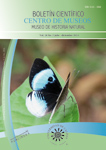Authors
Abstract
The torrent duck (Merganetta armata) inhabits torrential rivers along the Andes mountain range. This habitat specialization makes it vulnerable, reason why it is important to document population densities and their spatial and temporal variations, to understand responses to habitat alterations. The distribution and abundance of the torrent duck in the Quindío River and several small tributaries in the Department of Quindío, Colombia was evaluated in this work. Monthly counts of ducks during eight months (June 2011 to January 2012) were made along 8.5 km of the river. The species is distributed all along the Quindio river bed between 1,415 masl. as far as the junction of the Cárdenas and San José streams at 2,264 masl. and seven of its tributaries. The highest elevation record was at 3,325 masl. Monthly ducks density was negatively correlated with precipitation and varied between 4.1 and 6.8 individuals per km during months of low precipitation, versus less than one bird per km in the rainy months. This drop in density occurs because, when the river is fast-flowing, ducks probably move to other areas, among them to the smaller tributaries in the highest parts of the river. Densities in the Quindío River are high compared to those reported in studies for other places in Colombia, Peru and Argentina. It is necessary to carry out more studies which allow establishing duck movements in relation to the river's flow rate as well as the impact of the flow on the abundance of resources (aquatic insects) and breeding seasons.
References
ARBELÁEZ-CORTÉS, E., MARÍN-GÓMEZ, O.H., DUQUE-MONTOYA, D., CARDONA-CAMACHO, P.J., RENJIFO, L.M. & GÓMEZ, H.F., 2011. Birds, Quindío Department, Central Andes of Colombia.Check List Journal, 7(2):227-247.
CARDONA, W. & KATTAN, G., 2010. Comportamiento territorial y reproductivo del Pato de Torrentes (Merganetta armata) en la cordillera Central de Colombia. Ornitol. Colomb., 9:38-47.
COLLIER, K., 2004. Perturbation pathways affecting the avian lotic predator, blue duck, following a volcanic eruption. Freshw. Biol., 49:818-834.
COLLIER, K., MORALEE, S. & WAKELIN, M., 1993. Factors affecting the distribution of blue duck Hymenolaimus malacorhynchus on New Zealand rivers. Conserv. Biol., 63:119-126.
FAGAN, W.F., 2002. Connectivity, fragmentation, and extinction risk in dendritic metapopulations. Ecology, 83:3243-3249.
GODFREY, J., BRYANT, D. & MURRAY W., 2003. Energetics of blue ducks in rivers of differing physical and biological characteristics. Sci. Conserv., 214:35-68.
HILTY,S.L. & BROWN, W.L., 1986. A Guide to the birds of Colombia.Princeton Un. Press.
JOHNSGARD, P., 1966. The biology and relationships of the Torrent Duck. Wildfowl, 17:66-74.
JOHNSON, A., 1963. Notes on the distribution, reproduction and display of the Andean Torrent Duck, Merganetta armata. Ibis, 105:114-116.
KATTAN, G., RONCANCIO, N., BANGUERA, Y., KESSLER-RIOS, M., LONDOÑO, G.A., MARÍN O.H. & MUÑOZ, M.C., 2014. Spatial variation in population density of an endemic and threatened species, the Cauca Guan (Penelope perspicax). Trop. Conserv. Science, 7:161-170.
MADGE, S. & BURN, H., 1988. Waterfowl: An identification guide to the ducks, geese and swans of the world. London: Press Christopher Helm.
MCKINNEY, F., SIEGFRIED, W., BALL, I.& FROST, P., 1978. Behavioral specializations for river life in the African Black Duck (Anas sparsa). Z. Tierpsychol., 48:349-400.
MOFFETT, G., 1970. A study of nesting Torrent Ducks in the Andes.The Living Bird, 9: 5-27.
NARANJO, L. & ÁVILA, V., 2003. Distribución habitacional y dieta del Pato de Torrentes (Merganetta armata) en el parque regional natural Ucumarí en la cordillera Central de Colombia. Ornitol. Colomb., 1:22-28.
OJASTI, J., 2000. Manejo de fauna silvestre neotropical.Smithsonian Institution/MAB Biodiversity Program Series No. 5, Washington.
PERNOLLET, C., 2010. Selección de hábitat y efecto de las crecidas en el pato cortacorrientes (Merganetta armata armata) en dos ríos intervenidos de la región de O’Higgins (Chile central): implicancia para su conservación: Tesis de maestría, Universidad de Chile, Facultad de Ciencias Forestales y Conservación de la Naturaleza, Santiago de Chile.
PERNOLLET, C., ESTADES, C. & PAVEZ, E., 2012. Estructura social del pato cortacorrientes Merganetta armata armata, en Chile central. Bol. Chileno de Ornitol., 18(1-2): 23-34.
RAMÍREZ-URREA, L.M., Arbeláez-Cortés , E., Marín-Gómez, O.H. & Montoya, D., 2014. Composition patterns of waterbirds from La Vieja River, geographic valley of Cauca River, Colombia. Acta Biol. Col., 19(2).
SARDINA, P., RIVERA, L. & POLITI, N., 2011. Variación de la abundancia del pato de torrente (Merganetta armata) y características del hábitat en dos ríos de montaña de la provincia de Jujuy, Argentina. Ornitol. Neotrop., 22: 589-599.
STAUS, N.& WEAST, E., 2003. A survey of Peruvian torrent ducks (Merganetta armata leucogenis) on two rivers in Peru. Ornitol. Neotrop., 14: 269-273.
WRIGHT, J., 1965. Observations of behaviour of the Andean Torrent Duck. Condor, 67:535.
ZWICK, P., 1992. Stream habitat fragmentation, a threat to biodiversity. Biodiversity and Conservation, 1:80-97.

 PDF (Español)
PDF (Español)
 FLIP
FLIP


















